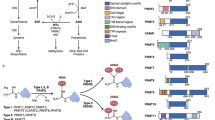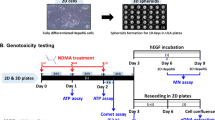Abstract
A review of the molecular mechanisms of nickel carcinogenesis has been compiled. This work is based upon approximately 20 years of research conducted in my laboratory. Molecular mechanisms of nickel carcinogenesis are considered from the point‐of‐view of the uptake of nickel, both soluble and insoluble particles in cells, its dissolution and its effects on heterochromatin. Molecular mechanisms by which nickel induces gene silencing in cells by DNA hypermethylation in mammalian cells and by inhibiting histone acetylation in yeast cells are also discussed.
Similar content being viewed by others
References
IARC: Chromium, nickel and welding. IARC Monographs on the Evaluation of Carcinogenic Risks to Humans, vol. 49. IARC, Lyon: 1–677, 1990
Doll R, Morgan LG, Speizer FE: Cancers of the lung and nasal sinuses in nickel workers. Br J Cancer 24: 623–632, 1970
Doll R, Mathews JD, Morgan LG: Cancers of the lung and nasal sinuses in nickel workers: A reassessment of the period of risk. Br J Ind Med 34: 102–105, 1977
Dunnick JK, Elwell MR, Radovsky AE, Benson JM, Hahn FF, Nikula KJ, Barr EB, Hobbs CH: Comparative carcinogenic effects of nickel subsulfide, nickel oxide, or nickel sulfate hexahydrate chronic exposures in the lung. Cancer Res 55: 5251–5256, 1995
Costa M, Mollenhauer HH: Phagocytosis of nickel subsulfide particles during the early stages of neoplastic transformation in tissue culture. Cancer Res 40: 2688–2694, 1980
Costa M: Molecular mechanisms of nickel carcinogenesis. Toxicol Environ Chem 49: 145–148, 1995
Abbracchio MP, Heck JD, Costa M: The phagocytosis and transforming activity of crystalline metal sulfide particles are related to their negative surface charge. Carcinogenesis 3: 175–180, 1982
Heck JD, Costa M: Surface reduction of amorphous NiS particles potentiates their phagocytosis and subsequent induction of morphological transformation in Syrian hamster embryo cells. Cancer Lett 15: 19–26, 1982
Costa M: Sequential events in the induction of transformation in cell culture by specific nickel compounds. Biol Trace Element Res 5: 285–295, 1983
Abbracchio MP, Simmons-Hansen J, Costa M: Cytoplasmic dissolution of phagocytized crystalline nickel sulfide particles: A prerequisite for nuclear uptake of nickel. J Toxicol Environ Health 9: 663–676, 1982
Costa M, Simmons-Hansen J, Bedrossian CW, Bonura J, Caprioli RM: Phagocytosis, cellular distribution, and carcinogenic activity of particulate nickel compounds in tissue culture. Cancer Res 41: 2868–2876, 1981
Kargacin B, Klein CB, Costa M: Mutagenic responses of nickel oxides and nickel sulfides in Chinese hamster V79 cell lines at the xanthine-guanine phosphoribosyl transferase locus. Mutat Res 300: 63–72, 1993
Conway K, Wang XW, Xu LS, Costa M: Effect of magnesium on nickel-induced genotoxicity and cell transformation. Carcinogenesis 8: 1115–1121, 1987
Sen P, Costa M: Induction of chromosomal damage in Chinese hamster ovary cells by soluble and particulate nickel compounds: Preferential fragmentation of the heterochromatic long arm of the X-chromosome by carcinogenic crystalline NiS particles. Cancer Res 45: 2320–2325, 1985
Sen P, Costa M: Pathway of nickel uptake influences its interaction with heterochromatic DNA. Toxicol Appl Pharmacol 84: 278–285, 1986
Klein CB, Conway K, Wang XW, Bhamra RK, Lin XH, Cohen MD, Annab L, Barrett JC, Costa M: Senescence of nickel-transformed cells by an X chromosome: Possible epigenetic control. Science 251: 796–799, 1991
Klein CB, Rossman TG: Transgenic Chinese hamster V79 cell lines which exhibit variable levels of gpt mutagenesis. Environ Mol Mutagen 16: 1–12, 1990
Klein CB: The genotoxicity and mutagenic mechanisms of Betapropriolactone in Chinese hamster and bacterial cells. Ph.D. Thesis. New York University, New York, 1988
Klein C, Snow E: Localization of the gpt sequence in transgenic G12 cells by fluorescent in situ hybridization. Environ Mol Mutagen 21: 35, 1993
Lee YW, Pons C, Tummolo DM, Klein CB, Rossman TG, Christie NT: Mutagenicity of soluble and insoluble nickel compounds at the gpt locus in G12 Chinese hamster cells. Environ Mol Mutagen 21: 365–371, 1993
Lee Y-W: Molecular mechanisms of 6-thioguanine resistance induced by carcinogenic nickel compounds in the transgenic G12 Chinese hamster cells: Relevance to an epigenetic mechanism of nickel carcinogenesis. Ph.D. Thesis. New York University, New York, 1995
Lee YW, Klein CB, Kargacin B, Salnikow K, Kitahara J, Dowjat K, Zhitkovich A, Christie NT, Costa M: Carcinogenic nickel silences gene expression by chromatin condensation and DNA methylation: A new model for epigenetic carcinogens. Mol Cell Biol 15: 2547–2557, 1995
Broday L, Cai J, Costa M: Nickel enhanced telomeric silencing in Saccharomyces cerevisiae. Mutat Res 440: 121–130, 1999
Broday L, Peng W, Kuo M-H, Salnikow K, Zoroddu M, Costa M: Nickel compounds are novel inhibitors of histone H4 acetylation. Cancer Res 60: 238–241, 2000
Johnson TL, Moyer MP: Normal human colon cells suppress malignancy when fused with colon cancer cells. In Vitro Cell Dev Biol 26: 1095–1100, 1990
Author information
Authors and Affiliations
Corresponding author
Rights and permissions
About this article
Cite this article
Costa, M., Sutherlandurname, J.E., Peng, W. et al. Molecular biology of nickel carcinogenesis. Mol Cell Biochem 222, 205–211 (2001). https://doi.org/10.1023/A:1017978500031
Issue Date:
DOI: https://doi.org/10.1023/A:1017978500031




